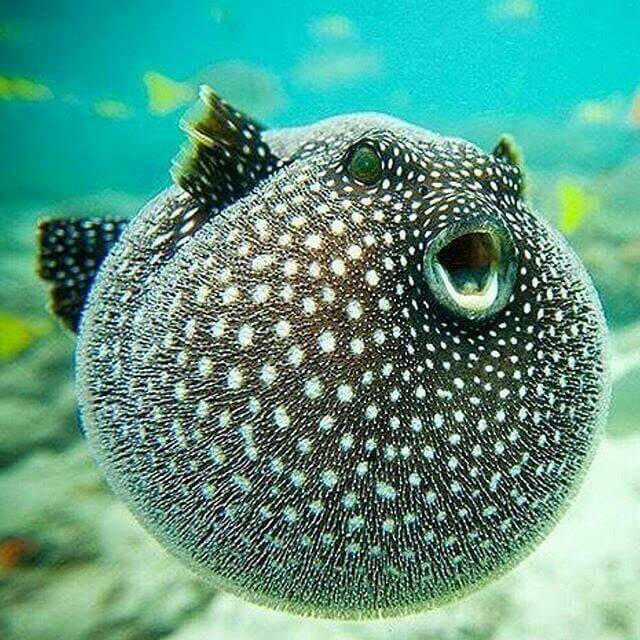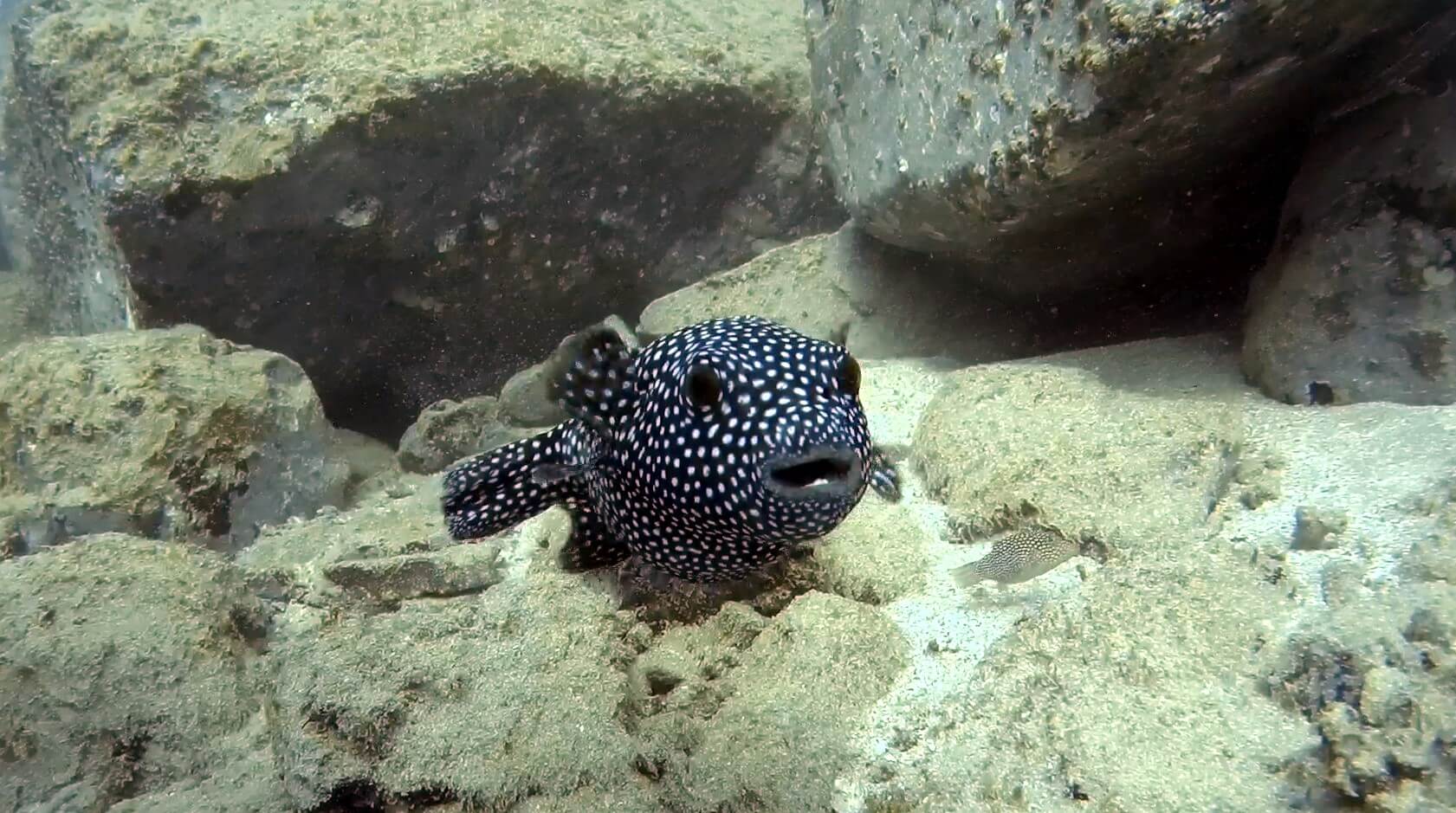Pufferfish
Hello human-fish hybrids! Here we are again for some exciting marine life in Zihuatanejo-Ixtapa with Dive Zihua. Our celebrity today is the famous pufferfish and porcupine fish.
Let ’s clarify a few things
Pufferfish or porcupine fish?
The term pufferfish is used quite often to design generally, fish that are able to puff themselves. There are some specifications that needs to be made and not all fish that can turn into a giant ball is a puffer.
One common mistake is the confusion between 2 families; Tetraodontidae and Diodontidae.
Pufferfish are part of the Tetraodontidae. They are characterised by thin hidden spines that only show when they puff. The Diodontidae have large external spines and are called most commonly porcupine fish. They are closely related but are not the same. Both are in the same order Tetraodontiformes with the boxfish which we will talk about in another post.
How do they do it?
It is quite simple really. The pufferfish have a very elastic stomach and they fill it out with water (or air when outside the water). This is how they obtain their balloon shape. All fish that can puff up do it the same way.
Why do they do it?
They do it as a defence mechanism. Pufferfish and friends are quite good at manoeuvring their body. The coalition of their pectoral, dorsal, lateral and caudal fins gives them good control for foraging food consisting of algae and small invertebrates and do sharp turns, unfortunately, they are relatively slow and non powerful swimmers. It is perfect for their feeding habits but on the down side it makes them easy targets for predators. When they puff they confuse the predator that was expecting a smaller and slimmer fish.
Porcupine fish have their large spines pointing outward when they puff making them even scarier to predators than puffers.
Puffing up is not the only defence mechanism. Before using this technique, they will try to use their ability to do sudden evasive burst which, affiliated with their good eyesight makes it their most common defence technique.
Their last natural defence is the fact that they are poisonous. Puffers and porcupine fish are full of tetrodotoxin, a neurotoxin that can be lethal. Some species do not have it like the northern puffer but most of them do. Remember a certain episode of The Simpsons named One fish, Two fish, Blowfish, Blue fish? Homer orders the Fugu in a sushi restaurant and has 24 hours to live because of its poison. The episode was base on that fact and also because pufferfish are a delicacy in some parts of Asia.

Pufferfish and porcupine fish diving with Dive Zihua
There are many kinds of puffers and porcupine fish in the Zihuatanejo-Ixtapa region. Here are the ones we see in our beautiful part of the pacific coast of Mexico.
Guineafowl Puffer – Arothron meleagris – Dark to Gold
A fan favorite, the Guineafowl Puffer is very common in the area. It has different colors depending on their life stage. The first stage is the Black stage which they display a dark blue to black colors with white spots all over the body.
During our dives, the black phase is very common. The golden phase as well but not as much as the other one. We have also encountered the mix phase with both colors. I quite enjoy this phase because it looks like the fish dropped some yellow paint on themselves. They normally are not afraid of divers and have a taste for cameras. They will parade in front of your lens for some adorable pictures.
Stripebelly Puffer – Arothron hispidus– A puffy giant
They are impressive with their size reaching up to 50cm/12inch. The color varies from grey to yellowish with a white belly with stripes. They have big round eyes. From all the puffers present around here, they really show a blowy oval shape. During our dives, they are quite common and like to lay on the bottom. We rarely see them in groups.
Longnose Puffer – Spheroides lobatus – King of sandy patches
The longnose puffer has a beautiful elongated diamond shape with a flat belly. The body is brown to olive green with small white spots and covered by small denticles. If you look at the body closely you will also see some bright blue or green dots all over it. They prefer sandy or weedy areas and rely on camouflage to hide from predators. During our dives, you can easily see them in all sizes with the young ones being so adorable. They are not scared of divers and easy to observe. At Caletta de Chon a dive site, you can see them everywhere but they might trick you by only letting their eyes out of the sand.
Porcupine fish
Spotted Porcupine fish – Diodon hystrix – The biggest
Has different shades of brown, olive and grey colors with dark spots all over the body and of course is covered with long spines that will only erect if the fish puff. They can grow up to 60 cm/2 ft. The eyes are big and mostly black.
During our dives, they are always present. I haven’t done a dive here without seeing one. On some dive sites, if we go down a buoy line, they normally are waiting for us very steady in the water column looking at us with there big curious eyes. It makes our descent quite special.
Balloonfish – Diodon holocanthus – Too many to count
Probably the most common in the area, the Balloonfish is difficult not to notice. Like the spotted porcupine fish, the body goes in different shades of brown to olive green, covered in spines with scattering of small brown spots. The eyes are honey brown. They can reach around 35cm/14 inch.
During our dives these guys always make me laugh. First of all they are camera junkies. They will swim away when they see you but the moment you show them your camera they turn around and strike a pose! One other thing is the way they stuck themselves between rocks to not be carried by the current. They always appear trapped and look at you in a funny way like they don’t want you to give any judgement. A golden mine for balloonfish is our small wreck in the bay called Fandango. There are so many around, it is pretty impressive.
A great place to see balloonfish is in a section of the Zacatoso reef dive site I call “Pufferland“. The name comes from that special place on the reef where dozens of balloonfish mostly, other puffers and porcupine fish swim out of their holes to welcome you to Pufferland. I think it is my favourite section of the reef, I love their curiosity!
Hope you enjoyed our little post about Pufferfish and Porcupine fish. We are very excited to take you visit them underwater. Join us for our next dive or snorkel trip they are waiting for you. https://divezihuatanejo.com/activities/diving/
https://divezihuatanejo.com/activities/snorkeling/
Time to jump in the water!
Maude Jetté – Owner, Scuba intructor and Marine Biologist at Dive Zihua
To learn more about Pufferfish and Porcupine fish click on the links

















